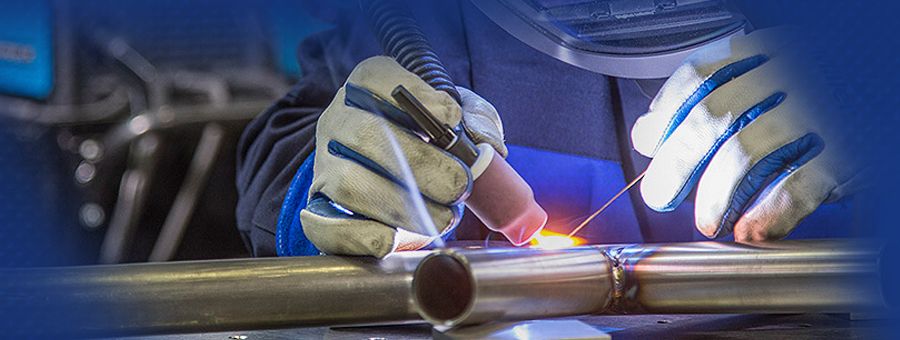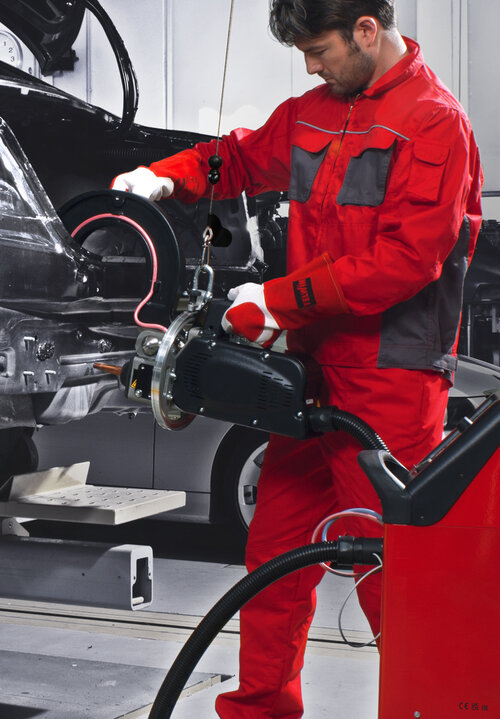Usual Welding Repair Issues and How to Address Them Efficiently
Welding repairs usually run into a range of issues that can jeopardize the integrity of the end product. Usual troubles include insufficient penetration, porosity, and imbalance, to name a few. Each defect offers special obstacles that need certain techniques for resolution. Understanding these problems is important for welders intending to boost their abilities and results. This discussion will certainly check out these typical welding fixing problems and efficient methods to address them.
Poor Infiltration
Poor infiltration occurs when the weld steel stops working to totally fuse with the base material, causing weak joints and possible architectural failures. This concern typically stems from not enough warmth input, incorrect electrode angle, or incorrect welding speed. Welders might run into inadequate penetration due to a miscalculation of the needed parameters for a details product thickness or type. In addition, contamination on the base product's surface can prevent effective bonding, aggravating the trouble. To deal with insufficient infiltration, welders must assure ideal setups on their tools and maintain a tidy work surface area. Normal assessment of welds is recommended to recognize any deficiencies early, enabling prompt modifications and the prevention of jeopardized structural honesty in bonded settings up.
Porosity
Porosity is an usual issue in bonded joints that manifests as little gas bubbles caught within the weld metal. This flaw can endanger the stability of the weld, leading to lowered toughness and possible failure under anxiety. Montana Mobile Welding and Repair Belgrade Fabrication. Porosity normally emerges from contamination, wetness, or improper welding techniques, which enable gases to run away into the liquified weld pool. To deal with porosity, welders must guarantee proper surface prep work, maintain a tidy workplace, and make use of ideal welding parameters. Furthermore, selecting the ideal filler product and protecting gas can reduce gas entrapment. Normal examination and screening of welds can assist recognize porosity early, ensuring timely rehabilitative actions are taken, thereby protecting the high quality and dependability of the bonded structure
Imbalance
Misalignment in welding can emerge from different elements, consisting of incorrect setup and thermal growth. Understanding the source is necessary for effective resolution. Several correction techniques are available to straighten elements and ensure architectural integrity.
Root causes of Imbalance
Welding misalignment typically originates from a range of underlying concerns that can compromise architectural honesty. One primary cause is incorrect fit-up of components prior to welding, which can cause gaps and uneven surfaces. Variants in thermal development throughout the welding process can additionally cause distortion, especially if the products being joined have different coefficients of development. In addition, poor securing and fixturing might stop working to hold elements securely in location, leading to motion throughout welding. Badly maintained tools, consisting of welding makers and devices, might introduce variances in the weld bead, further adding to imbalance. Operator mistake, stemming from inadequate training or experience, can also play a considerable duty in producing misaligned welds.

Adjustment Strategies Readily Available
Addressing imbalance efficiently requires a combination of corrective techniques tailored to the details issues handy. One typical technique is making use of components or jigs to hold parts in the proper position during welding, ensuring consistent alignment. Additionally, preheating the materials can help in reducing distortion and enhance fit-up. For significant misalignment, mechanical realignment strategies, such as using hydraulic jacks or clamps, can be utilized to correct the setting before welding. Post-weld warm therapy may also be essential to soothe tensions caused by misalignment. Finally, mindful examination and change during the configuration phase can avoid misalignment problems from becoming considerable issues, promoting a smoother welding process and improving total architectural honesty.
Distortion
Distortion is a typical obstacle in welding that can develop from various aspects, including irregular cooling and heating. Comprehending the sources of distortion is necessary for implementing efficient prevention techniques. Resolving this problem not just boosts structural stability yet likewise boosts the general high quality of the weld.
Causes of Distortion
When subjected to the extreme warm of welding, materials typically undertake changes that can cause distortion. This phenomenon mostly arises from thermal development and tightening throughout the welding procedure. As the weld location warms up, the product increases; upon cooling, it gets, which can create inner tensions. Additionally, uneven home heating throughout a workpiece can aggravate these stresses, leading to bending or bending. The kind of product likewise plays a significant role; steels with differing thermal conductivity and coefficients of growth might respond in a different way, causing unforeseeable distortions. In addition, inadequate joint layout and poor fixturing can add to imbalance during welding, increasing the likelihood of distortion. Comprehending these causes is vital for effective welding repair work and avoidance approaches.
Prevention Techniques
Effective avoidance strategies for distortion during welding focus on managing heat input and making certain correct joint style. Preserving a constant warmth input assists to reduce thermal development and contraction, which can result in distortion. Using methods such as preheating the work surface can likewise reduce the temperature slope, advertising uniform home heating. Additionally, picking appropriate joint designs, such as T-joints or lap joints, can improve security and decrease tension concentrations. Implementing appropriate fixturing to secure the workpieces in place better help in keeping positioning throughout the welding procedure. Finally, staggered welding sequences can disperse warm extra uniformly, preventing local distortion. By using these techniques, welders can significantly lower the likelihood of distortion and boost the general high quality of their welds.
Fracturing
Splitting is a common problem come across in welding repair services, often resulting from various aspects such as improper cooling prices, product option, or inadequate joint preparation. The incident of fractures can substantially jeopardize the integrity of the weld, causing possible failings during operation. To address this concern, welders have to first evaluate the root triggers, making sure that materials are suitable and appropriately picked for the details application. Furthermore, regulating the cooling rate throughout the welding process is important; quick air conditioning can cause stress and anxiety and bring about splitting. Correct joint design and preparation also contribute to lessening the risk. Applying these methods can enhance weld high quality and longevity, look at this site inevitably lowering the likelihood of fracturing in ended up weldments.

Incomplete Combination
A significant concern in welding fixings is insufficient combination, which happens when the weld metal does not sufficiently bond with the base product or previous weld passes - Montana Mobile Welding and Repair Belgrade Fabrication. This issue can bring about weaknesses in the joint, possibly endangering the integrity of the welded structure. Aspects adding to incomplete combination consist of not enough warm input, improper welding strategy, and contamination of the surface areas being signed up with. To address this concern effectively, welders must assure appropriate pre-weld cleansing and surface preparation, along with change their welding specifications to attain appropriate infiltration and fusion. Normal evaluation during the welding process can also assist recognize insufficient blend early, permitting for timely rehabilitative measures to enhance the general top quality of the weld
Overheating
While welding fixings can boost structural stability, overheating presents a considerable obstacle that can cause material degradation. Extreme heat throughout welding can alter the mechanical homes of steels, causing decreased stamina, enhanced brittleness, and warping. This phenomenon is particularly important in high-stress applications where structural dependability is paramount. Identifying overheating can include aesthetic examinations for staining or distortion, as well as keeping an eye on temperature during the welding process. To this article alleviate the dangers linked with getting too hot, welders must utilize ideal strategies, such as controlling heat input, adjusting traveling speed, and making use of ideal filler products. Furthermore, applying pre- and post-weld warmth therapies can help recover material residential properties and boost the overall top quality of the fixing, making sure lasting performance and security.
Frequently Asked Questions
What Are the Usual Signs of a Welding Flaw?

Just How Can I Test My Welds for High quality?
To evaluate welds for quality, one can make use of aesthetic assessments, ultrasonic screening, and radiographic approaches. Each strategy assures architectural integrity, recognizes problems, and validates adherence to defined standards, eventually boosting the integrity of the bonded joints.
What Safety Safety Measures Should I Take While Welding?
When welding, one must prioritize safety and security by putting on proper personal safety tools, making sure proper ventilation, safeguarding combustible materials away, preserving a clean work space, and recognizing environments to stop injuries and accidents.
Can I Repair a Weld Without Remodeling the Entire Joint?
Repairing a weld without remodeling the whole joint is possible, depending on the damage (Welding). Techniques such as grinding, adding filler material, or making use of a welding procedure can efficiently attend to particular problems while protecting the surrounding framework
What Equipment Are Essential for Effective Welding Repairs?
Important tools for efficient welding repair work include a welding equipment, wire brush, mill, safety gear, clamps, and filler materials. Each device plays an essential role in making certain quality and safety and security throughout the fixing procedure. Porosity typically occurs from contamination, wetness, or improper welding methods, which allow gases to escape right into the liquified weld pool. Poorly maintained devices, consisting of welding equipments and devices, might present disparities in the weld bead, further contributing to misalignment. When subjected to the intense warmth of welding, materials usually go through adjustments that can lead to distortion. find more info Breaking is a common concern experienced in welding repair services, commonly resulting from numerous factors such as inappropriate air conditioning rates, material choice, or poor joint prep work. A substantial concern in welding repair work is incomplete fusion, which occurs when the weld steel does not effectively bond with the base product or previous weld passes.